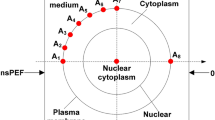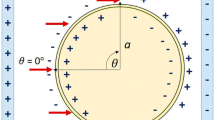Abstract
In this paper, the membrane electroporation induced by the terahertz electric field is simulated by means of the molecular dynamics method. The influences of the waveform and frequency of the applied terahertz electric field on the electroporation and the unique features of the process of the electroporation with the applied terahertz electric field are given. It shows that whether the electroporation can happen depends on the waveform of the applied terahertz electric field when the magnitude is not large enough. No pore appears if the terahertz electric field direction periodically reverses, and dipole moments of the interfacial water and the bulk water keep reversing. The nm-scale single pore forms with the applied terahertz trapezoidal electric field. It is found that the average pore formation time is strongly influenced by the terahertz electric field frequency. An abnormal variation region that shows decline exists on the correlation curve of the average pore formation time and the trapezoidal electric field frequency, whereas the overall trend of the curve is increasing. The decrease of the water oriented polarization degree results in the increase of the electroporation time, and the abnormal variation region appearance may be related to the drastic change of average water hydrogen bond number that is resulted from the resonance of water hydrogen bond network and the applied electric field. Compared to the nanosecond electric pulse and constant electric field, the numbers of the water protrusions and the water bridges are smaller and the pore formation time is relatively longer with the applied terahertz electric field.




















Similar content being viewed by others
References
Allen MP, Tildesley DJ (2017) Computer simulation of liquids. Oxford University Press, Oxford
Andrew RL (2001) Molecular modeling principles and applications, 2nd edn. Pearson Education Limited, Essex
Baum CE, Stone AP, Tyo JS (eds) (2007) Ultra-wideband short-pulse electromagnetics 8. Springer, New York
Craviso GL, Chatterjee P, Maalouf G, Cerjanic A, Yoon J, Chatterjee I, Vernier PT (2009) Nanosecond electric pulse-induced increase in intracellular calcium in adrenal chromaffin cells triggers calcium-dependent catecholamine release. IEEE Trans Dielectr Electr Insul 16:1294–1301
Darden T, York D, Pedersen L (1993) Particle mesh Ewald: an N⋅log (N) method for Ewald sums in large systems. J Chem Phys 98:10089–10092
Delemotte L, Tarek M (2012) Molecular dynamics simulations of lipid membrane electroporation. J Membr Biol 245:531–543
Dev SB, Rabussay DP, Widera G, Hofmann GA (2000) Medical applications of electroporation. IEEE Trans Plasma Sci 28:206–223
Essmann U, Perera L, Berkowitz ML, Darden T, Lee H, Pedersen L. G (1995) A smooth particle mesh Ewald method. J Chem Phys 103:8577–8593
Feller SE, Zhang Y, Pastor RW, Brooks BR (1995) Constant pressure molecular dynamics simulation: the Langevin piston method. J Chem Phys 103:4613–4621
Garon EB, Sawcer D, Vernier PT, Tang T, Sun Y, Marcu L, Koeffler HP (2007) In vitro and in vivo evaluation and a case report of intense nanosecond pulsed electric field as a local therapy for human malignancies. Int J Cancer 121:675–682
Gurtovenko AA, Vattulainen I (2005) Pore formation coupled to ion transport through lipid membranes as induced by transmembrane ionic charge imbalance: atomistic molecular dynamics study. J Am Chem Soc 127:17570–17571
Hua YY, Wang XS, Zhang Y, Yao CG, Zhang XM, Xiong ZA (2012) Intense picosecond pulsed electric fields induce apoptosis through a mitochondrial-mediated pathway in HeLa cells. Mol Med Rep 5:981–987
Humphrey W, Dalke A, Schulten K (1996) VMD: visual molecular dynamics. J Mol Graph 14:33–38
Jia J, Xiong ZA, Qin Q, Yao CG, Zhao XZ (2015) Picosecond pulsed electric fields induce apoptosis in a cervical cancer xenograft. Mol Med Rep 11:1623–1628
Joshi RP, Song J, Schoenbach KH, Sridhara V (2009) Aspects of lipid membrane bio-responses to subnanosecond ultrahigh voltage pulsing. IEEE Trans Dielectr Electr Insul 16:1243–1250
Kalé L, Skeel R, Bhandarkar M, Brunner R, Gursoy A, Krawetz N, Schulten K (1999) NAMD2: greater scalability for parallel molecular dynamics. J Comput Phys 151:283–312
Kirsch SA, Böckmann RA (2016) Membrane pore formation in atomistic and coarse-grained simulations. Biochim Biophys Acta (BBA) 1858:2266–2277
Kotnik T, Miklavčič D (2006) Theoretical evaluation of voltage inducement on internal membranes of biological cells exposed to electric fields. Biophys J 90:480–491
Marty M, Sersa G, Garbay JR, Gehl J, Collins CG, Snoj M, Pavlovic I (2006) Electrochemotherapy–an easy highly effective and safe treatment of cutaneous and subcutaneous metastases: results of ESOPE (European Standard Operating Procedures of Electrochemotherapy) study. Eur J Cancer Suppl 4:3–13
Martyna GJ, Tobias DJ, Klein ML (1994) Constant pressure molecular dynamics algorithms. J Chem Phys 101:4177–4189
Polak A, Velikonja A, Kramar P, Tarek M, Miklavčič D (2014) Eloctroporation threshold of POPC lipid bilayers with incorporated polyoxyethylene glycol (C12E8). J Phys Chem B 119:192–200
Rols MP (2006) Electropermeabilization a physical method for the delivery of therapeutic molecules into cells. Biochim Biophys Acta (BBA) 1758:423–428
Schoenbach KH, Xiao S, Joshi RP, Camp JT, Heeren T, Kolb JF, Beebe SJ (2008) The effect of intense subnanosecond electrical pulses on biological cells. IEEE Trans Plasma Sci 36:414–422
Semenov I, Xiao S, Kang D, Schoenbach KH, Pakhomov A. G (2015) Cell stimulation and calcium mobilization by picosecond electric pulses. Bioelectrochemistry 105:65–71
Siu SW, Vácha R, Jungwirth P, Böckmann RA (2008) Biomolecular simulations of membranes: physical properties from different force fields. J Chem Phys 128:03B620
Stacey M, Stickley J, Fox P, Statler V, Schoenbach K, Beebe SJ, Buescher S (2003) Differential effects in cells exposed to ultra-short high intensity electric fields: cell survival DNA damage and cell cycle analysis. Mutat Res 542:65–75
Stacey M, Fox P, Buescher S, Kolb J (2011) Nanosecond pulsed electric field induced cytoskeleton nuclear membrane and telomere damage adversely impact cell survival. Bioelectrochemistry 82:131–134
Tarek M (2005) Membrane electroporation: a molecular dynamics simulation. Biophys J 88:4045–4053
Tieleman DP (2004) The molecular basis of electroporation. BMC Biochem 5:10
Tieleman DP, Leontiadou H, Mark AE, Marrink SJ (2003) Simulation of pore formation in lipid bilayers by mechanical stress and electric fields. J Am Chem Soc 125:6382–6383
Tokman M, Lee JH, Levine ZA, Ho MC, Colvin ME, Vernier PT (2013) Electric field-driven water dipoles: nanoscale architecture of electroporation. PloS ONE 8:e61111
Vernier PT, Levine ZA, Ho MC, Xiao S, Semenov I, Pakhomov A. G (2015) Picosecond and terahertz perturbation of interfacial water and electropermeabilization of biological membranes. J Membr Biol 248:837–847
Wang C, Youle RJ (2009) The role of mitochondria in apoptosis. Annu Rev Genet 43:95–118
Xiao S, Schoenbach KH, Baum CE (2008) Time-domain focusing radar for medical imaging. In: Proc. URSI XXIX Gen. Assembly URSI 1–4
Xiao S, Guo S, Nesin V, Heller R, Schoenbach KH (2011) Subnanosecond electric pulses cause membrane permeabilization and cell death. IEEE Trans Biomed Eng 58:1239–1245
Xu Y, Havenith M (2015) Perspective: Watching low-frequency vibrations of water in biomolecular recognition by THz spectroscopy. J Chem Phys 143:170901
Author information
Authors and Affiliations
Corresponding author
Ethics declarations
Conflict of interest
All authors declare that they have no conflict of interest.
Ethical Approval
This article does not contain any studies with human participants or animals performed by any of the authors.
Informed Consent
Informed consent was obtained from all individual participants included in the study.
Rights and permissions
About this article
Cite this article
Tang, J., Yin, H., Ma, J. et al. Terahertz Electric Field-Induced Membrane Electroporation by Molecular Dynamics Simulations. J Membrane Biol 251, 681–693 (2018). https://doi.org/10.1007/s00232-018-0045-8
Received:
Accepted:
Published:
Issue Date:
DOI: https://doi.org/10.1007/s00232-018-0045-8




